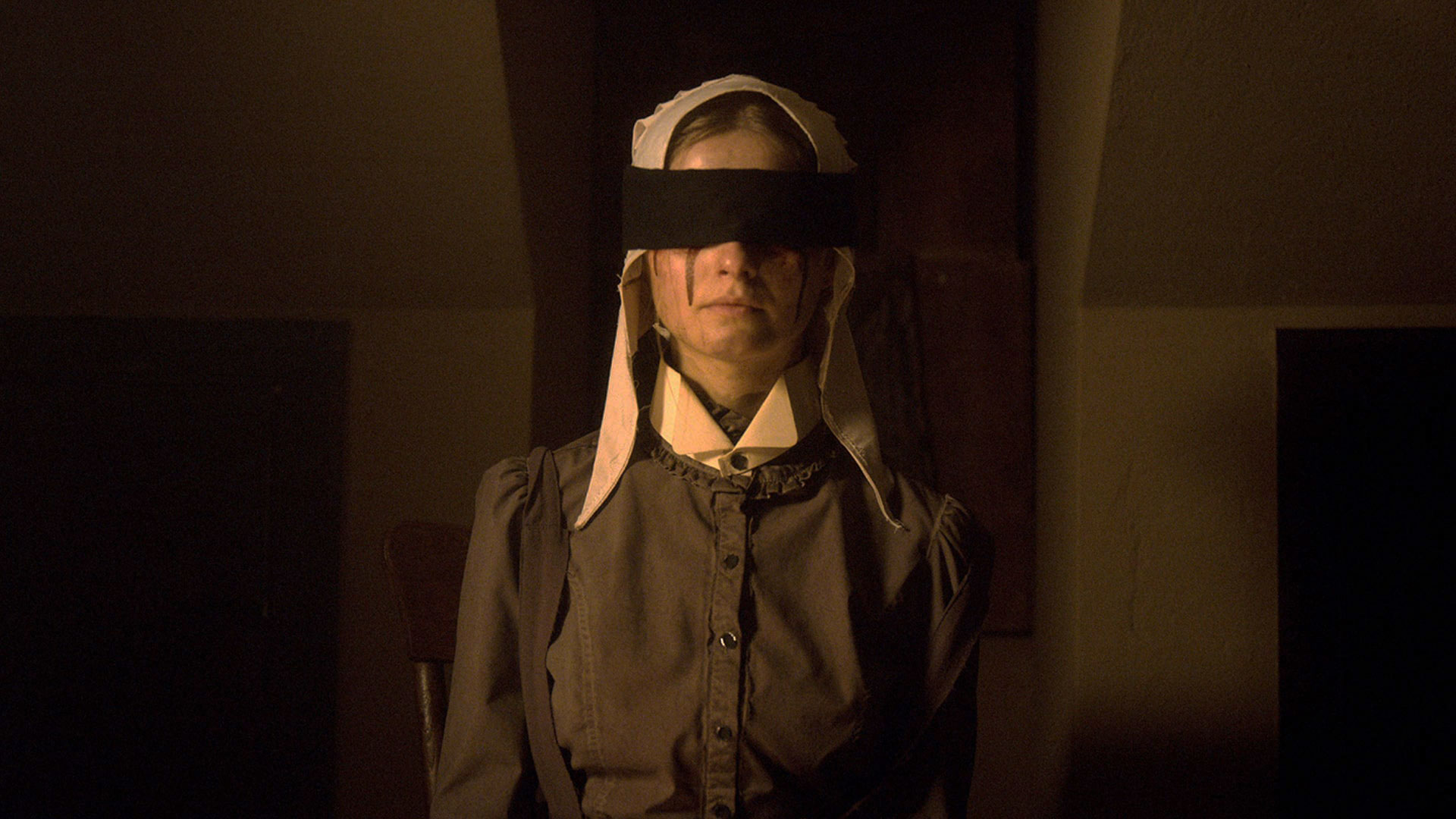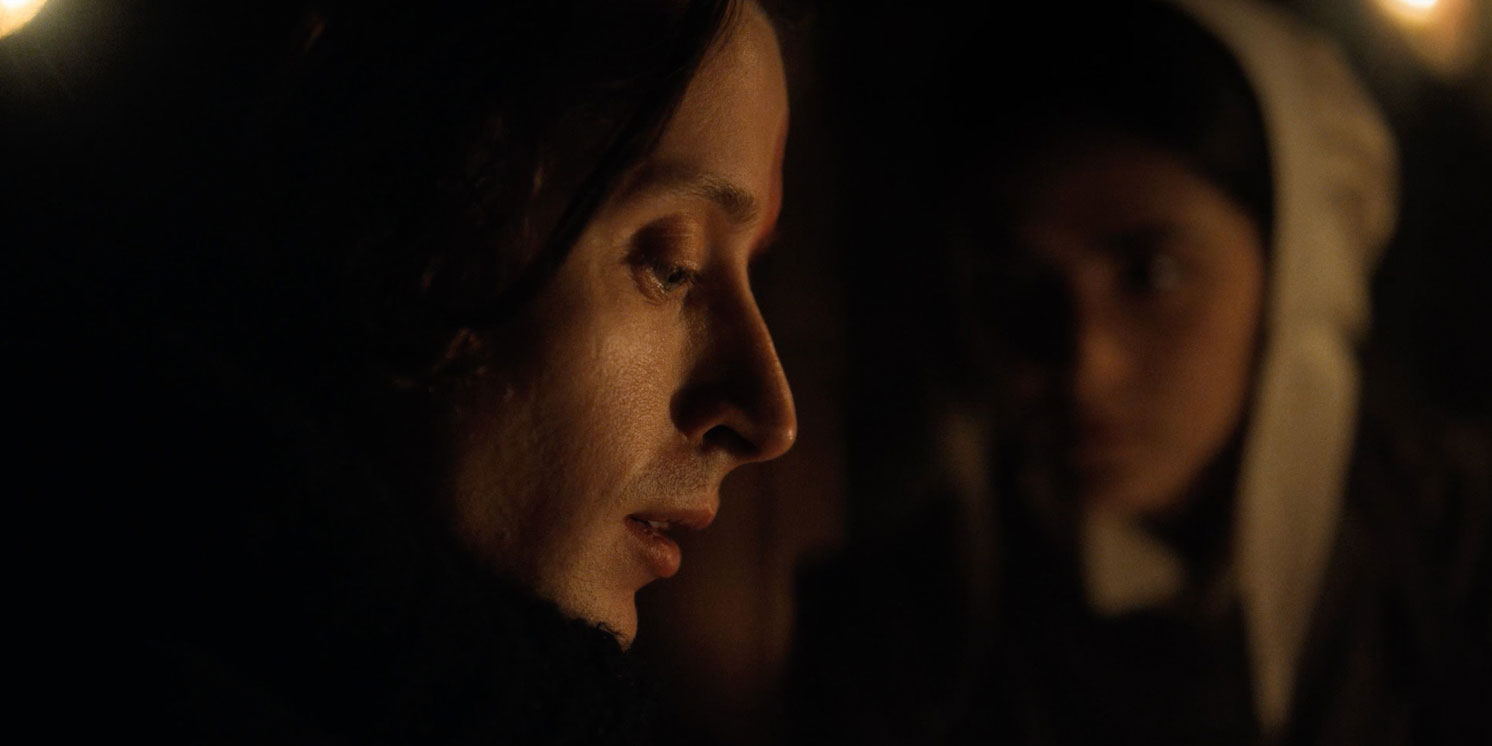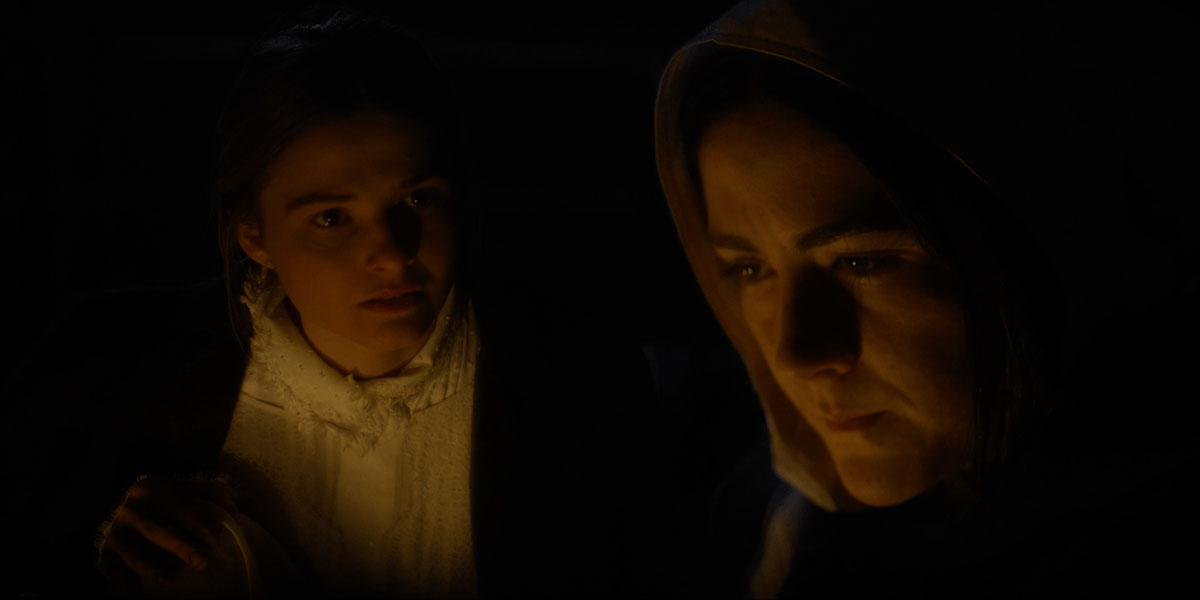
Forbidden love and religious oppression clash in Edoardo Vitaletti’s The Last Thing Mary Saw, which has its European Premiere at this year’s Arrow Video FrightFest. Set in a devout community in 19th century New York, the film stars Beautiful Boy’s Stefanie Scott as Mary and Orphan’s Isabelle Fuhrman as Eleanor, the housemaid with whom Mary begins a dangerous liaison. When punishment comes, it is severe and under the watchful eye of Judith Roberts’ cold, calculating Matriarch.
Rory Culkin adds offbeat menace as The Intruder, someone who enters the women’s world as matters become even more malevolent. A dark tale of folklore horror, with a supernatural undercurrent reminiscent of The Witch or The Curse of Audrey Earnshaw, The Last Thing Mary Saw is a movie that lingers long after the lights have gone up.
We spoke to writer/director Vitaletti about his impressive debut feature, the inspirations behind it, and the challenges of shooting a period piece in a New York winter.
The Last Thing Mary Saw will be available on Shudder from 20th January 2022
Rob Daniel: How would you describe The Last Thing Mary Saw?
Edoardo Vitaletti: That’s a good question. I would describe it as a period horror drama, set in rural New York in 1843. It’s about a young woman, Mary, raised in an oppressively religious household. But, her challenges really start when she begins a romantic relationship and bonds with the housemaid, Eleanor.
It is a story of how their relationship and the family dynamics unravel, after the discovery of ageless forces that hover over the house. But, at its heart it is about two people wanting to be together in a world that puts a label on them, and tries as hard as they can to separate them.
RD: Even though it’s a period piece that central idea still resonates now. Where did inspiration for the film come from?
EV: Yeah, it’s a period piece and as a species maybe we’ve gotten a little bit better collectively, but I’m not entirely sure. (laughs) Regarding my entry point for the story, I’m originally from Italy and was raised in a very Catholic environment and country. As I grew up I began to learn about some of the contradictions in the religion. My frustrations with that turned into the antagonistic forces we see in the movie. That was a big source of inspiration.
When I was developing the story my entry way was personal research on Northern European art. Not from the 19th century primarily, but I noticed a lot of captivating visual threads, such as the representation of funerals, family ways, and female subjects. Very stark and dark tones. There is a great Danish painter Vilhelm Hammershøi, who my DP David Kruta and I would reference when we started working together.
From the subjects of those paintings I began to develop the story and themes. The relationship between Mary and Eleanor, the figure of the housemaid, the house, the funeral and the wake. Doing further research on the folklore and the religious fervour of 19th century New York state and the northeast, it all started coming together.
RD: Interesting that you mention a Danish painter. I thought The Last Thing Mary Saw might have drawn from the films of Danish director Carl Theodor Dreyer, but it sounds like you went back before movies.
EV: Yeah, when I’m thinking about a story or writing a movie, I’m careful with what I watch or what I read. It’s easy for images or ideas from other places to trickle into your script. I’m generally not watching a lot of movies or shows while I’m writing, so having access to stuff like paintings that pre-dates movies is useful. Visual resources from a time period you can only imagine are important when you’re portraying that era.

RD: One of the ways the film successfully sells the period is in the cast. Their faces really fit the costumes and surroundings. Could you tell me how you assembled the cast, particularly Mary, Eleanor, The Intruder and The Matriarch?
EV: I was truly blessed with a fantastic, committed and curious cast. The first person who got involved with the movie was Stefanie Scott who plays Mary. In our first conversation, we saw the story the same way, we were curious about working on the accent and body language for the time period. Plus of course the emotional importance of the story. I then began working with Isabelle Fuhrman right after Stefanie.
Isabelle and Stefanie were already friends and that provided a lot of their chemistry and connection in the movie. They were very comfortable acting around each other, and I like to think their friendship strengthened from making this movie. We created this internal space for the three of us where we could feel very comfortable. When it came to costuming and hair styling we were all discovering these things together. This was a period you can only read about or see in paintings, so that process was fun with them.
Rory Culkin and Judith Roberts came after. My first meeting with Rory was one of the most fun two hours I’ve ever had. We were discussing the script and his very odd, very dark and very cruel character. The Intruder has a particularly neurotic vibe to him, and Rory being the fantastic actor he is was able to step into that darkness, to understand it and portray it in a way that it had a soul. All of which are important when you have a dark and evil character. Rory was intrigued by this, haunted by it in the right way.
The same goes for Judith. We had great conversations when talking about The Matriarch. It was important to us we build this overarching presence that speaks through looks and body language. Judith has a great presence on set; she’s one of the loveliest people you’ll ever meet, but she can easily step into that darkness too.
My collaboration with those four was delightful, and also the rest of the cast.
RD: What was it like shooting a film that required a consistently oppressive atmosphere?
EV: We were working very fast and there was a lot to get done in a short amount of time. Like every movie really. But the atmosphere on set was extremely amicable. One of the wonderful things about working with Isabelle is that she is a great actor, but always brings such a friendly and light atmosphere to set. The same with Stefanie. So we were definitely able to separate ourselves from the subject matter. That said, it was a very cold and dark winter in New York, and that did make its way into the storytelling. The sets were dark, because in some scenes only the candles and fireplace were on, chairs were creaking, and outside was so unforgivingly cold.
RD: This was your first feature, with all the challenges that come with that. Were you able to shoot pretty much the script you had written, or were there any compromises? Also, what were some of the challenges you experienced?
EV: Compromises will always happen on a movie, it’s something that transcends budget. But one of the most difficult things for us was getting the location. We wanted to shoot on location in a real house to get that sense of time. And it was really difficult finding that place, not much has been left untouched from the 1800s in the greater New York landscape. I saw a lot of places and none of them quite worked because when they looked perfect they were very impractical. We eventually locked the place we found not too long before shooting began, so that was a real challenge.
Regarding compromise, to be honest there were a lot of things that we embraced. Such as the fact that in this period people only had candles to light their homes and fireplaces to keep warm. Our candles were actually candles. It’s easy to fall into the trap that more money means more quality, but for a story like this we embraced the difficulties, because in a small way it matched the difficulties of the people from that time. That turned it from a challenge to a very helpful tool. We didn’t have the money to create sets on a big soundstage, but what we had was this real house, built around this time period. So it all came together nicely.

RD: Absolutely, the film would have lost power if it was on glossy stages. The verisimilitude flows off the screen and you fall into the hard world these characters live in.
EV: Right! That goes for the shooting style too. My DP and I were specific about it looking painterly, that the camera would be very still. There are some scenes where we put the camera in one position and said we were going to film the scene in one or two shots. The question then was how do we fill the frame in a way that makes it interesting, with the characters and props and the lighting.
RD: The film plays with an ambiguity around the supernatural. Were you ever tempted to make that more or less ambiguous?
EV: I’m happy with where the ambiguity landed in the movie. My goal was to give some answers, but to leave audiences with those pleasant questions as to what they have just seen. Movies that don’t leave you with questions are not that interesting to me. But, I also think there is a nice balance, and you don’t want people leaving the room thinking what the hell did I just watch?! The balance I have in the story feels truthful to how I feel about the supernatural; there are things that go beyond something I can explain.
RD: Yes, it is a film that allows for great conversations after it ends.
EV: Yeah, it’s fun to talk and pore over the movie you just watched. I like films that linger in your mind for a few days. There are things in them that you cannot explain. You feel it emotionally and understand it emotionally, even if you can’t quite explain it with words. When you’re dealing with the supernatural in storytelling, I think that is a pretty good landing spot.
RD: The film is playing at this year’s Arrow Video FrightFest. Have you attended the festival before?
EV: I have not had the chance, no. And heartbreakingly, because of current rulings around travel and my visa situation in the US, I’m not going to be able to attend it in person even though it will be screened to an audience. But, I’ve heard crazy and awesome things about the festival, and I’m saying this closing my eyes, wishing I could go! So, it’s a bittersweet experience!
RD: I’ll be going along and cannot wait to see The Last Thing Mary Saw one on a big screen. It is a shame current events mean you can’t attend.
EV: Totally, we live in a changed world. On the one hand there is a silver lining that more people now have access to festivals than in the past, because festivals are offering the opportunity to view movies at home. But I do look forward to having an in-person screening, and I hope people have fun with the movie at FrightFest.
RD: Final question, can you tell us about what you’re working on next?
EV: For the next movie I’m thinking of working in that same dark sphere. There’s nothing lined up specifically, but many people I worked with on this movie, particularly at the producing end, I’m hoping to work with again. Fingers crossed soon I’ll be able to tease a little more what’s next. But, I will be sticking to that dark folklore aspect, because I love it so much.
Thanks to Edoardo Vitaletti and Clint Morris for making this interview possible
Rob Daniel
Twitter: rob_a_Daniel
Podcast: The Movie Robcast

